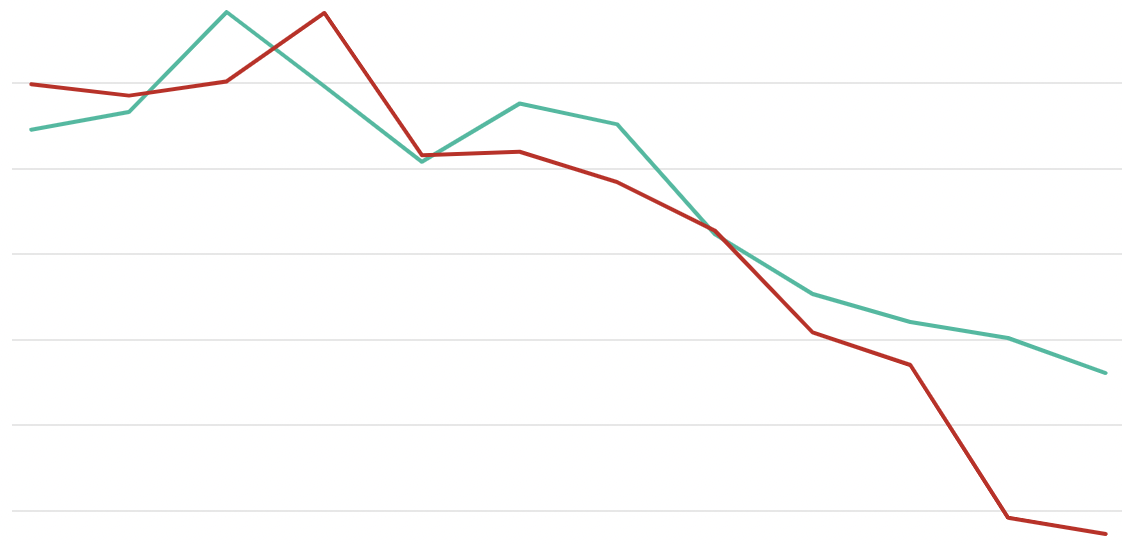One of the major stories of the recent federal election was the share of the vote for the major parties (defined here as Labor, Liberal and Nationals), and how it has been declining for decades, with a big drop in 2022.
I decided to look up the same information for Victorian state elections.
The story is not quite as dramatic as at federal elections, but the trend is still there. Over 99% of the primary vote in 1985 was cast for the major parties, and this number dropped to 78% in the Legislative Assembly in 2018.
The Legislative Council trend tended to be similar for most of this time period, even after the introduction of proportional representation (PR) in 2006, but dropped precipitously in 2014, such that the primary vote for the major parties in 2018 was 9% lower in the upper house than in the lower house.
First up, this chart shows the primary vote for Labor and the combined primary vote for the Liberal and National parties (sometimes in coalition) since 1979.
The major party primary vote in Victoria tended to be higher than in federal elections. It peaked at over 99% in 1985. In comparison, the major party primary vote at the 1984 and 1987 federal elections was around 92%.
Over the last four decades, the trend in Victoria has bounced around less than at the Commonwealth level, but apart from an uptick in the late 1990s the trend has been consistent.
Next I wanted to check out the Victorian upper house. The major party vote has consistently been lower for the Senate than the House for decades, with a gap of 6.4% in 2022. But while the Senate has been proportionally elected since 1949 (and thus a more hospitable electoral system for minor parties), Victoria's upper house only became proportional in 2006. Prior to the 2006 election, the Legislative Council consisted of single-member provinces electing members for eight years. This system did not have any particular advantage for minor parties.
But it is interesting that, while a large gap has opened up between the major party vote in the Assembly and the Council, that didn't happen until the third election under PR in 2014.
While the Liberal, Labor and Nationals parties between them polled 78% in the lower house, they polled just 68.6% in the upper.
This coincided with a significant increase in the number of parties running for the upper house, with ballot papers growing significantly in every region, as I explained in yesterday's post.
So what can we expect in 2022? I see no reason to see a reversal in the trend, with a strong field of independents running alongside a large number of parties.
While polling can struggle to identify exactly how much of the vote will go to minor parties and independents, there's evidence to suggest there will be a drop in the major party vote. The last two Resolve polls had the combined Labor/Coalition vote at 69-70%, while Essential had it at 67.5% (potentially there are some undecided votes also included which lowers that figure), although Newspoll has the number well into the 70s.
Whatever happens, the major party hold on power in Victoria does appear to be slipping. In coming days I'll be exploring some of the symptoms of this trend - the increasing numbers of non-classic lower house races, and of course the dynamics of how the upper house has changed with the higher minor party vote.




Because I don’t live in Victoria, I am only taking a passing interest in this election. But from afar, it seems that the anti-lockdown resentment may still be a thing. Is that reflected in the candidates?
@Neil Flanagan, yes, it is likely to be. Check out the current list of VEC-registered parties: www dot vec dot vic dot gov dot au / candidates-and-parties / registered-political-parties / currently-registered-parties
The major party primary votes being lower in the Legislative Council in 2018 was not universal. In Melton both major parties had higher primary votes in the Legislative Council, as did the Greens, Animal Justice Party and Victorian Socialists. The factors likely leading to this were the independents soaking up votes in the Legislative Assembly and the 13 candidates driving up the informal vote in the Assembly (nearly twice the informal vote in the Legislative Council, probably disproportionately hurting the ALP primary in the Assembly).
This will probably be the first election in decades where both the LNP and Labor primary votes drop concurrently.
This phenomenon happened at the federal level in 2019 and 2022 and in NSW in 2019. This didn’t happen at the 1998 federal election when One Nation made its federal debut but it did happen at the 1998 QLD election.
The major parties need to get better candidates. Labor is likely to lose Albert Park, as Nina Taylor is moving from the upper house. She is a terrible candidate, comes across as rehearsed and vacuous. the Greens or an independent might win the seat based on the high quality of their candidates.
I hope more SFF Candidates get up across the State, they are doing a very job in the NSW Parliament keeping the LNP aware of the huge mismanagement that they are doing and have done.
@Janey
Labor are easily going to hang on in Albert Park. The Lib vote there is dead, and the Greens are running a tiny campaign relative to how theoretically likely they are to win the seat. They also didn’t announce their candidate until like, the first week of October. It’s one to watch in future but I doubt the Greens, or the Independent, are knocking Labor off in Albert Park this election.
Comments are closed.